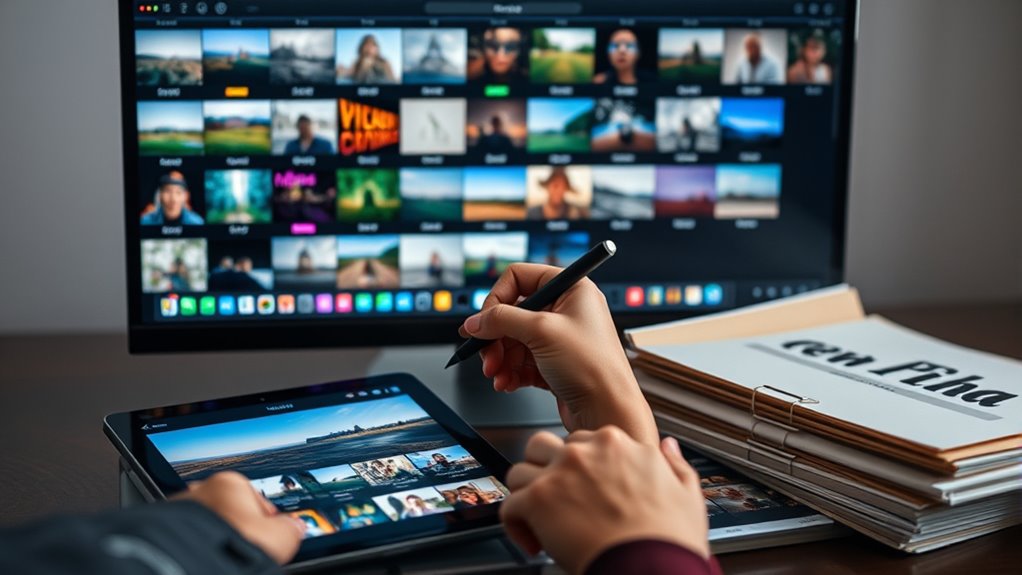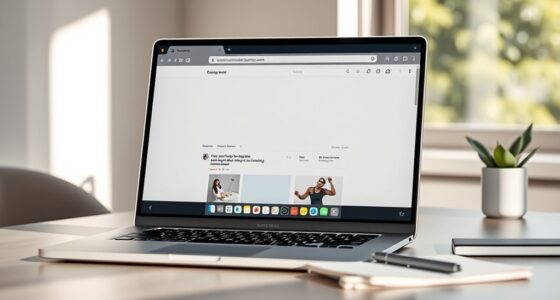To maintain a clean photo library, regularly review your images and decide what to delete, keep, or archive. Remove blurry, duplicate, or sentimental photos you no longer need, and keep the meaningful ones that evoke emotion or mark milestones. Archive less-frequent photos to external drives or cloud storage to free space and guarantee long-term preservation. Consistently organizing and maintaining your collection helps reduce clutter and stress — keep exploring for more tips to keep your library manageable.
Key Takeaways
- Regularly review and evaluate photos for sentimental value, quality, and duplicates to maintain a manageable library.
- Delete blurry, poor-quality, or unnecessary images to reduce clutter and enhance overall organization.
- Keep meaningful photos that evoke emotion or mark milestones, organizing them into themed albums or folders.
- Archive rarely-accessed images to external drives or cloud storage to free up space and preserve memories safely.
- Establish routine maintenance with consistent categorization, naming, and review practices to sustain a tidy and efficient photo library.

A cluttered photo library can quickly become overwhelming, making it hard to find the images you really want. When your digital clutter piles up, it’s easy to feel paralyzed by the sheer volume of photos, many of which might be duplicates, blurry shots, or no longer meaningful. To regain control, you need a solid plan for photo organization that involves regularly deleting, keeping, or archiving images. This process not only declutters your library but also ensures that your favorite memories remain accessible and easy to find.
Start by setting aside dedicated time to review your photos. As you go through each image, ask yourself if it holds sentimental value, if it’s of decent quality, or if it’s a duplicate of another. If the answer is no to all three, it’s time to delete. Removing unnecessary files reduces digital clutter and keeps your library manageable. Don’t get caught up in perfection; aim for a practical and consistent approach that allows you to quickly identify what’s worth keeping. When you delete, do so confidently—less clutter means less mental stress and faster searches later.
Set aside time to review photos, delete duplicates and poor shots, and keep only what truly matters for a clutter-free library.
Next, decide which photos you want to keep permanently. These are your treasures—shots that evoke emotion, mark important milestones, or showcase special moments. To make this process efficient, consider creating albums or folders based on themes, events, or dates. This way, your photo organization system becomes intuitive, and finding specific images becomes effortless. Keep only what truly matters, and avoid hoarding every snap, which can make navigation cumbersome.
Archiving is your third option. For images you want to hold onto but don’t need frequent access to, consider transferring them to external drives or cloud storage. This frees up space on your primary device while preserving your digital memories safely. Plus, archiving offers peace of mind, knowing that even if your device crashes, your precious photos remain intact. Incorporating content organization best practices, such as consistent naming conventions and categorization, can further streamline your archive management. Incorporate regular archiving sessions into your photo hygiene routine to prevent future clutter from sneaking in.
Frequently Asked Questions
How Often Should I Review My Photo Library?
You should review your photo library every three to six months to stay organized. During this time, you can perform photo tagging to easily find images later and delete duplicates or blurry shots to optimize storage. Regular reviews help you keep only meaningful photos, making storage more efficient and your library easier to navigate. Consistent maintenance guarantees your collection remains manageable and clutter-free over time.
What Tools Can Help Organize My Photos Efficiently?
You can organize your photos efficiently with tools like Google Photos or Apple Photos, which offer handy features like photo tagging and automatic organization. Don’t worry about losing control; these tools sync with cloud backup, ensuring your images are safe. Photo tagging helps you find photos quickly, while cloud backup keeps everything secure. Using these features makes managing your library less overwhelming and keeps your memories easily accessible.
How Do I Identify Duplicate or Blurry Photos Automatically?
You can identify duplicate and blurry photos automatically using tools like Gemini Photos, Google Photos, or Adobe Lightroom. These apps use duplicate detection algorithms to find similar images and can flag blurry photos based on focus and sharpness analysis. Simply run their scan features, review the suggested duplicates or blurry shots, and decide whether to delete, keep, or archive. This streamlines your photo organization and keeps your library clutter-free.
What’s the Best Method to Archive Old Photos Securely?
Imagine your treasured memories tucked safely into a digital vault. To archive old photos securely, you should use cloud storage with robust encryption methods like AES-256. This creates a fortress around your images, accessible only to you. Guarantee you enable two-factor authentication for extra protection. This way, your memories remain private and protected from prying eyes, ready for you to revisit whenever nostalgia hits.
How Can I Recover Accidentally Deleted Images?
If you’ve accidentally deleted images, act quickly for photo recovery. Check your device’s trash or recently deleted folder, as many platforms keep deleted photos temporarily. If you can’t find them there, use specialized recovery software designed for photo recovery. Avoid saving new files on the same storage to prevent overwriting. With prompt action, you increase your chances of successfully recovering your images after accidental deletion.
Conclusion
Keeping your photo library tidy can boost your productivity and free up storage. Did you know that the average person has over 3,000 photos on their device, but only 20% are meaningful? Regularly deleting, keeping, or archiving helps you find what matters quickly and reduces clutter. So, take a few minutes today to organize your photos—you’ll breathe easier knowing your library is clean, manageable, and ready for new memories.









